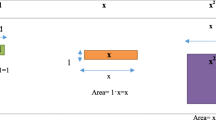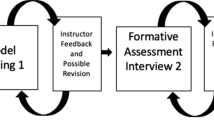ABSTRACT
The focus on professional noticing in mathematics education has recently gained increased interest as researchers work to understand how and what is noticed and how this translates into practice. Much of this work has focused on the professional noticing practices of inservice teachers and preservice teachers, with less attention focused on those educating teachers. This research explores how novice mathematics teacher educators professionally notice as they engage in teaching experiments and create models of student’s mathematical thinking. Findings indicate the novice teacher educators are including some evaluative comments in their professional noticing practices but lack in-depth interpretive analysis about student thinking and rarely make connections between student’s thinking and the broader principles of teaching and learning. These findings provide evidence for the importance of supporting teacher educators with developing their abilities to professionally notice.
Similar content being viewed by others
References
An, S. & Wu, Z. (2012). Enhancing mathematics teachers’ knowledge of students’ thinking from assessing and analyzing misconceptions in homework. International Journal of Science and Mathematics Education, 10, 717–753.
Dirkin, G. R. (1983). Cognitive tunneling: Use of visual information under stress. Perceptual and Motor Skills, 56, 191–198.
Franke, M., Webb, N., Chan, A., Battey, D., Ing, M., Freund, D. & De, T. (2009). Eliciting student thinking in elementary mathematics classrooms: Practices that support understanding. Journal of Teacher Education, 60, 380–392.
Goleman, D. (1985). Vital lies, simple truths: The psychology of self-deception. New York: Simon & Schuster.
Goodwin, C. (1994). Professional vision. American Anthropologist, 96, 606–633.
Jacobs, V., Lamb, L., Philipp, R. & Schappelle, B. (2011). Deciding how to respond on the basis of children’s understandings. In M. G. Sherin, V. Jacobs & R. Philipp (Eds.), Mathematics teacher noticing (pp. 97–116). New York: Routledge.
Jacobs, V. R., Lamb, L. L. & Philipp, R. A. (2010). Professional noticing of children’s mathematical thinking. Journal for Research in Mathematics Education, 41, 169–202.
Kazemi, E., Elliott, R., Mumme, J., Carroll, C., Lesseig, K. & Kelley-Petersen, M. (2011). Noticing leaders’ thinking about videocases of teachers engaged in mathematics tasks in professional development. In M. G. Sherin, V. Jacobs & R. Philipp (Eds.), Mathematics teacher noticing (pp. 188–203). New York: Routledge.
Mason, J. (2011). Noticing: Roots and branches. In M. G. Sherin, V. Jacobs & R. Philipp (Eds.), Mathematics teacher noticing (pp. 35–50). New York: Routledge.
Miller, K. (2011). Situation awareness in teaching: What educators can learn from video-based research in other fields? In M. G. Sherin, V. Jacobs & R. Philipp (Eds.), Mathematics teacher noticing (pp. 51–65). New York: Routledge.
Norton, A. H. & McCloskey, A. (2008). Teaching experiments and professional development. Journal of Mathematics Teacher Education, 11, 285–305.
Sherin, M. G., Jacobs, V. & Philipp, R. (2011). Situating the study of teacher noticing. In M. G. Sherin, V. Jacobs & R. Philipp (Eds.), Mathematics teacher noticing (pp. 3–14). New York: Routledge.
Star, J. & Strickland, S. (2008). Learning to observe: Using video to improve preservice mathematics teachers’ ability to notice. Journal of Mathematics Teacher Education, 11, 107–125.
Steffe, L. & Thompson, P. (2000). Teaching experiment methodology: Underlying principles and essential elements. In A. E. Kelley & R. A. Lesh (Eds.), Handbook of research design in mathematics and science education (pp. 267–306). Mahwah, NJ: Lawrence Erlbaum Associates.
Stigler, J. & Hiebert, J. (1999). The teaching gap. New York: The Free Press.
United States Math Recovery Council (2005, July) Math recovery overview. http://www.saine.com/mathrecovery/itree/uploads/MR%20Overview%20White%20Paper.pdf.
van Es, E. (2011). A framework for learning to notice student thinking. In M. G. Sherin, V. Jacobs & R. Philipp (Eds.), Mathematics teacher noticing (pp. 134–151). New York: Routledge.
van Es, E. A. & Sherin, M. G. (2008). Mathematics teachers’ “learning to notice” in the context of a video club. Teaching and Teacher Education, 24, 244–276.
Weiland, I., Hudson, R. & Amador, J. (2014). Preservice formative assessnent interviews: The development of competent quetioning. International Journal of Science and Mathenatics Education,12, 329–352
Author information
Authors and Affiliations
Corresponding author
Rights and permissions
About this article
Cite this article
Amador, J. PROFESSIONAL NOTICING PRACTICES OF NOVICE MATHEMATICS TEACHER EDUCATORS. Int J of Sci and Math Educ 14, 217–241 (2016). https://doi.org/10.1007/s10763-014-9570-9
Received:
Accepted:
Published:
Issue Date:
DOI: https://doi.org/10.1007/s10763-014-9570-9




